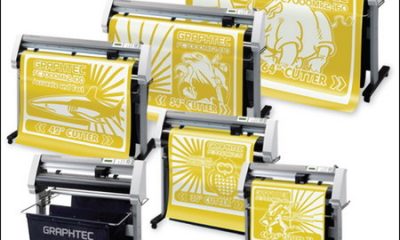We’ve all heard the news reports about depleted natural resources, teeming landfills and global warming. Talking heads have argued ad nauseum about the problems’ severity and their causes, but people of most political stripes acknowledge that we should be mindful of how we consume and dispose of materials.
Conservation and recycling are common practices in many households (sacrosanct in some), but, in the commercial arena, decisionmakers commonly perceive that “green” or “sustainable” – the latter has become today’s buzzword for the long-term feasibility of materials and processes – products are too expensive or unwieldy for mainstream use.
The sign industry has borne an unfair brunt of responsibility when resource scarcities have struck the United States. During World War II, many on the home front viewed illuminated signage as an extravagance – and possible targets for would-be enemy bombers – and fabrication materials were readily sacrificed for the war effort (of course, many young signmakers were serving their country). During the 1970s’, oil embargoes and gas-price spikes, some zealous conservationists advocated greatly restricting, if not outlawing, electric-sign use after business hours to conserve electricity. Thankfully, these and another long-ago initiatives, such as an electric-sign ban in Times Square, ultimately failed.
However, signage’s increasing vitality and diversity – and generally positive public perception – carry a double-edged sword. More signage in more retail and civic environments equates to more energy consumption and more public scrutiny. Although the sign industry represents a Lilliputian to other Gullivers (healthcare, hospitality, retail, etc.), it can do its fair share to conserve energy and materials.
Frankly, the sign industry’s newfound enthusiasm to adopt such methods currently outpaces its knowledge. A telling moment occurred last January at ST Media Group’s Signage and Graphics Summit in Tucson. When an attendee asked a panel of end users about the use of recycled, energy-efficient or sustainable materials, the panel and audience didn’t have an answer. Why? Signmakers follow the market. Until very recently, the market largely showed indifference towards such products.
Advertisement
However, that’s changing. Whether a client has made a proactive decision to reduce his environmental footprint, must meet tightening environmental regulations or simply wishes to boost the company’s image to gain a competitive edge, demand continues to grow for such new-generation signage.
Though the sign industry remains on a sizeable learning curve, some manufacturers and providers have developed products that provide tangible environmental benefits. Some signshops have studied and implemented more ecologicallyoriented materials and methods.
Though this is by no means an exhaustive, industry-wide treatise on the subject, here’s a look at ways a few companies from various industry perspectives prac¬tice environmentaly sensitive and/or sustainable signamaking.
Vinyl
Unquestionably, vinyl remains the signshop substrate king. According to ST’s 2006 Vinyl Survey (see February 2007, page 96), responding signshops increased their annual budget for it by 12%, the highest yet reported. Further, respondents estimated vinyl decorates nearly 70% of their signage. Therefore, PVC-related products arguably represent the industry most prolific contribution to the waste stream.
Recycling processes can reclaim vinyl. However, sign vinyls contain integral, pressure-sensitive adhesives that impede the recycler’s machinery; and separating the adhesive from the facestock compromises the vinyl’s integral strength. Also, breaking down adhesive-coated vinyl releases such noxious chemicals as chlorine and residual plasticizers.
Advertisement
However, vinyl manufacturers have taken steps to implement conserving practices. Oracal USA (Jacksonville, FL) now ships products in materials made of recycled plastic and paper. At its production facilities in the United States and Germany (the latter is known as Orafol), Oracal has incinerators that burn solvent-adhesive by-products to generate manufacturing-process energy, which has reduced natural-gas dependence and VOC emissions. The company has also added a new roll-core production line that incorporates cardboard scrap into the process.
David Grant, Oracal USA’s vice president of marketing, offered suggestions to signshops for recycling or reusing vinyl-roll materials: “Kraft-paper liners can be recycled in many municipalities. However, silicone-coated paper liners and scrap vinyl film aren’t practical for recycling. Therefore, we recommend that signshops reuse these materials for packing and shipping whenever possible. When shipping graphics, many shops use liner material as slip sheets between roll layers as an alternative to polystyrene peanuts. Most roll cores may also be locally recycled.”
Miles Clark, Avery Graphics’ (Painesville, OH) architectural market-segment manager, hailed architectural fabrics as an environmentally friendly media. Because they lack PVC, they don’t require petroleum-derivative consumption, contain no heavy metals, and they lack an integral adhesive. Clark suggests tradeshows, museums and retail environments use them because of their texture and sheen, though cotton and canvas aren’t recommended for outdoor use.
Part two: Inks and Printing
Also check out: Five Easy Ways to Conserve and Recycle


 Tip Sheet1 week ago
Tip Sheet1 week ago
 Photo Gallery2 days ago
Photo Gallery2 days ago
 Ask Signs of the Times3 days ago
Ask Signs of the Times3 days ago
 Real Deal1 week ago
Real Deal1 week ago
 Benchmarks6 days ago
Benchmarks6 days ago
 Editor's Note2 weeks ago
Editor's Note2 weeks ago
 Women in Signs1 week ago
Women in Signs1 week ago
 Photo Gallery1 week ago
Photo Gallery1 week ago












